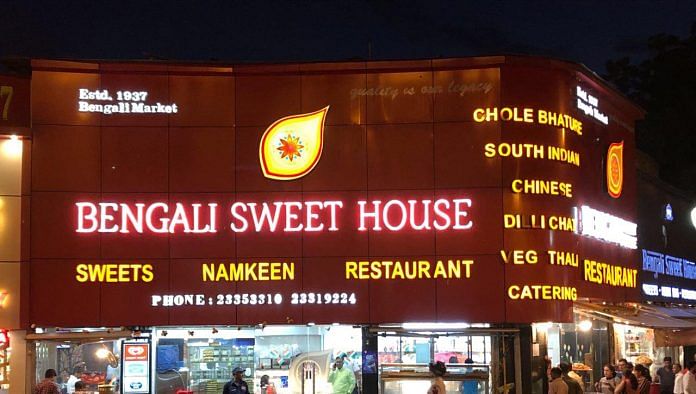Innovation and entrepreneurship are joined at the hip. The very nature of business is such that it demands recasting and remodelling of old patterns. Bengali Sweet House, one of Delhi’s most well-known eateries, is an apt example of how a small novelty can spin big results. During the early 20th century, when street food was sold by vendors pulling small hand carts, Lala Bhim Sain came up with a novel plan to serve popular and authentic street food items of Delhi – all together from the comfort of his sit-down eatery.
“This singular restyling feature by tauji (uncle) made our modest eatery a landmark of Delhi,” says Girish Agarwal, the third-generation owner of Bengali Sweet House.
The story began in 1920 when Jai Kishandas and his family, well-known mithaiwallas in Rajasthan’s Bikaner, came to Delhi for the medical treatment of his grandson Sitalal. They set up residence near Qutub Minar in Mehrauli on the outskirts of Delhi. The shift implied an uprooting from the family’s ancestral mooring. As a result, some familial turbulence was sure to follow. One of Kishandas’ grandsons, Bhim Sain, left home and began to work at a small canteen at the kachehri or the sessions court at what is present day police station at Parliament street in Delhi.
Entrepreneurial instinct
In those days of scanty literacy, Bhim Sain, with his ability to read and speak English soon became a star employee – popular with the large number of British and Indian officials and lawyers who stopped by the session court canteen for a coffee and a snack. During his time at the canteen, Bhim understood the nature of the evolving capital and its residents. He realised that customers needed different things at different hours of the day — aloo poori for breakfast, samosa with some meetha as a midday snack, chole bhature for lunch, chaat and chai as evening refreshment, and dal-roti thali to end the day.
As his deeply ingrained entrepreneurial DNA began to stir alive — Bhim Sain yearned for a life beyond his modest job at a low key Canteen. He mulled over his innovative thought of moving away from the set pattern of his familial business of a ‘mithai ki dukaan’ and instead opened a 360-degree outlet that gave dilli wallas their various favorite street foods plus his Bikaneri traditional mithai — all under one roof.
Meanwhile, the new imperial capital, with its imposing Raisina Hill citadel and posh Connaught Place market, was evolving rapidly. As stately avenues like Kingsway Road (now Rajaji Marg) and Queensway (now Janpath) came up — these British hubs were out of bounds for commoners. Almost everyone who worked on these projects or served at the various offices of the imperial government had to travel on narrow roads through kikar thickets of Delhi’s Ridge to go to Purani Dilli for their shopping needs.
Therefore, British town planners decided to create two small market hubs for junior officers, independent traders and merchants. The area north of Parliament was planned as Gole Market. The region south of the Parliament was planned near a local rail head. A public auction of the land pocket was held – which was won by Lala Bengali Mal Lohia, a businessperson from Purani Dilli and hence the colony and the adjoining market got named ‘Bengali Market’ after the founders name.
Also read: Mugli Ghutti 555 was homegrown brand from Paharganj. Then it challenged Baidyanath, Dabur
New shop, old and new recipes
Lala Lohia set up a small circular marketplace and leased out its various shops to local businessmen. Bhim Sain chose a corner shop. “In 1937, when the shop opened, the most popular items were traditional sweets like patisa, sohan halwa, kala jam, and sone tikki. Not many people relish these traditional mithais anymore. In fact, we have lost the original recipe for sone tikki. In the 1940s and 50s, people liked seasonal sweets as per the natural bounties of the season. For instance, petha and parmal mithai in summer; gur ka halwa, gur ka ghevar, gajar ka halwa, dal ka halwa in winter. Mithai made with milk were liked throughout the year — so rabri, kulfi, and doodh ki barfi were evergreen items,” said Agarwal.
Forever on the lookout for new recipes, Bhim Sain would invite talented chefs from other cities to recreate their traditional sweets. Founders of Bengali Sweet House claim that they were one of the first to introduce authentic ‘bengali rasgulla’ to mainstream Delhi clientage. This dessert became so popular that the shop that was until then unnamed and unbranded began to be known as ‘Bengali Sweet House’.
“We have much to thank for our location. It’s priceless. We are close to Parliament so most top statesmen of the country have visited us, from Vajpayee sahib to Indira Gandhi onwards. We are close to Connaught Place, FICCI, and other business hubs, so top industrialists of the country come here. Mukesh Ambani ho ya Charat Ram — they have visited us. Then NSD, Triveni, Sri Ram Centre, Kamani Auditorium are next door. So, from Ebrahim Alkazi to Shah Rukh Khan — every one has sat at my shop and relished the chole bhature. We have received tremendous affection from all Dilliwalas,” says Agarwal, beaming from behind the counter filled with spicy dal biji and crisp namakparas.
This article is part of a series called BusinessHistories exploring iconic businesses in India that have endured tough times and changing markets. Read all articles here.
(Edited by Humra Laeeq)



